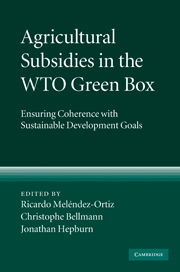Book contents
- Frontmatter
- Contents
- List of contributors
- Preface
- Acknowledgements
- List of abbreviations
- 1 Overview
- PART I The recent evolution of agricultural trade policy reform
- PART II The focus, extent and economic impact of green box subsidies
- PART III Green box subsidies and developing countries
- PART IV Green box subsidies and the environment
- PART V Looking forward: how can change take place?
- 19 Improving monitoring and surveillance of green box subsidies
- 20 EU subsidy reform: options for achieving change
- 21 Subsidy reform in the US context: deviating from decoupling
- 22 Agricultural trade policy reform in Japan: options for achieving change
- 23 Towards a green box subsidy regime that promotes sustainable development: strategies for achieving change
- Appendix: Text of Annex 2 of the WTO Agreement on Agriculture (“the green box”)
- Index
- References
20 - EU subsidy reform: options for achieving change
from PART V - Looking forward: how can change take place?
Published online by Cambridge University Press: 03 May 2010
- Frontmatter
- Contents
- List of contributors
- Preface
- Acknowledgements
- List of abbreviations
- 1 Overview
- PART I The recent evolution of agricultural trade policy reform
- PART II The focus, extent and economic impact of green box subsidies
- PART III Green box subsidies and developing countries
- PART IV Green box subsidies and the environment
- PART V Looking forward: how can change take place?
- 19 Improving monitoring and surveillance of green box subsidies
- 20 EU subsidy reform: options for achieving change
- 21 Subsidy reform in the US context: deviating from decoupling
- 22 Agricultural trade policy reform in Japan: options for achieving change
- 23 Towards a green box subsidy regime that promotes sustainable development: strategies for achieving change
- Appendix: Text of Annex 2 of the WTO Agreement on Agriculture (“the green box”)
- Index
- References
Summary
Introduction
The European Commission initiated, at the end of 2007, a process to review the reform of the Common Agricultural Policy (CAP) agreed in 2003 and which applies until 2014. These negotiations initiated the debate about the future of the European budget for the agricultural sector after 2014.
The present and future of the CAP cannot properly be understood without an appreciation of the World Trade Organisation (WTO) negotiations. The WTO's Uruguay Round was supposed to reduce agricultural subsidies, but the 1994 Agreement on Agriculture nonetheless was sufficiently vague to allow rich countries, including the European Union, to pass reforms that would not end trade-distorting agricultural subsidies and hence would not stop dumping. Furthermore, the 2001 Doha Ministerial Declaration stated that WTO member states were committed to sustainable development, and that future progress in trade liberalisation would take into consideration and address the needs and vulnerabilities of developing countries.
A central problem is the assumption of the “minimally trade distorting” nature of green box measures, which is a very subjective concept. This ambiguity has allowed the European Union and United States, instead of complying with WTO requirements, simply to shift subsidies from the amber and blue boxes and hide them in the green box, allowing them to maintain or even increase the high level of support provided by these countries to agricultural production.
- Type
- Chapter
- Information
- Agricultural Subsidies in the WTO Green BoxEnsuring Coherence with Sustainable Development Goals, pp. 583 - 603Publisher: Cambridge University PressPrint publication year: 2009

